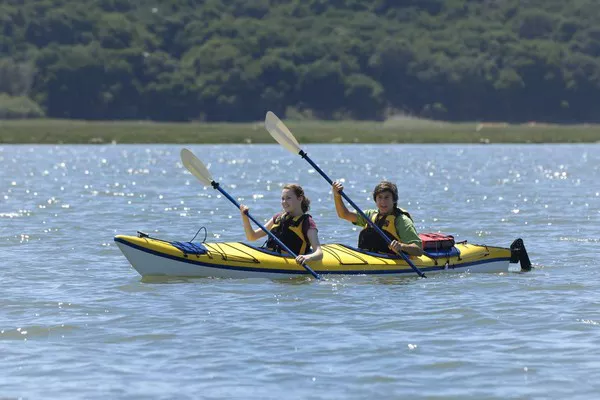Paddle kayaking is an exciting water sport. It combines fitness with adventure. Whether you are on a serene lake or tackling white-water rapids, kayaking offers a unique experience. This guide will teach you how to use a paddle kayak effectively.
Understanding the Basics of Paddle Kayaking
What is Paddle Kayaking?
Paddle kayaking involves using a double-bladed paddle to propel a small boat, called a kayak, through the water. Kayaks are narrow and come in various designs. They are typically for one or two people.
Types of Kayaks
There are different types of kayaks for different purposes:
- Recreational Kayaks: Best for calm waters like lakes and slow-moving rivers.
- Touring Kayaks: Designed for long-distance paddling on open water.
- Whitewater Kayaks: Built to handle the turbulence of fast-moving rivers.
- Sit-On-Top Kayaks: Great for warm weather and easy to get in and out of.
- Inflatable Kayaks: Portable and easy to store.
Essential Gear for Kayaking
- Kayak: Choose the right type based on your activity.
- Paddle: A double-bladed paddle is essential.
- Personal Flotation Device (PFD): Always wear a life jacket.
- Helmet: Necessary for whitewater kayaking.
- Spray Skirt: Keeps water out of the kayak.
- Dry Bag: For storing essentials and keeping them dry.
Getting Started with Paddle Kayaking
Choosing the Right Kayak
Your kayak choice depends on your activity. For beginners, a recreational kayak is ideal. It is stable and easy to maneuver.
Selecting the Correct Paddle
Paddles come in different lengths. Your height and the width of your kayak will determine the best paddle size. Generally, taller paddlers and wider kayaks require longer paddles.
Safety Precautions
Safety is paramount in kayaking. Always wear a PFD. Learn basic water rescue techniques. Check the weather and water conditions before heading out.
Learning Basic Kayaking Techniques
Entering and Exiting the Kayak
From a Dock: Sit on the dock, place your legs in the kayak, and slide in.
From Shore: Position the kayak parallel to the shore. Sit in the seat and then slide your legs in.
Holding the Paddle
Grip the paddle with both hands, slightly wider than shoulder-width. The blades should be vertical when they enter the water.
Basic Strokes
- Forward Stroke: Dip one blade into the water near your feet and pull it towards your hips.
- Reverse Stroke: Dip the blade near your hips and push it towards your feet.
- Sweep Stroke: Used for turning. Sweep the paddle in a wide arc from the front to the back of the kayak.
- Draw Stroke: Used for moving sideways. Place the paddle blade in the water parallel to the kayak and pull towards you.
Advanced Kayaking Techniques
Turning and Maneuvering
- Edging: Tilt the kayak slightly to one side to help with turning.
- Bracing: Use the paddle to prevent capsizing.
- Rolling: An advanced technique to right the kayak if it capsizes.Paddling in Different Conditions
- Calm Water: Focus on smooth, efficient strokes.
- Choppy Water: Maintain balance and use bracing techniques.
- Whitewater: Use quick, powerful strokes and be prepared to maneuver rapidly.
Rescue Techniques
- Self-Rescue: Learn how to re-enter the kayak from the water.
- Assisted Rescue: Work with a partner to get back in the kayak.
- Eskimo Roll: An advanced technique to right the kayak without exiting it.
Kayaking Fitness and Training
Building Strength and Endurance
Kayaking is a full-body workout. It strengthens your core, arms, and shoulders. Incorporate strength training exercises like rowing, planks, and shoulder presses.
Improving Paddling Technique
Focus on proper form. Engage your core and use your torso to power your strokes. Practice regularly to build endurance.
Cross-Training for Kayakers
- Swimming: Improves overall fitness and water confidence.
- Yoga: Enhances flexibility and balance.
- Cycling and Running: Builds cardiovascular endurance.
Environmental Awareness and Responsibility
Respecting Wildlife
Keep a safe distance from wildlife. Avoid disturbing natural habitats.
Leave No Trace Principles
- Pack Out Trash: Take all your belongings and trash with you.
- Stay on Established Trails and Waterways: Prevent damage to natural areas.
- Respect Other Paddlers: Share the water and be courteous.
Planning Your Kayaking Trip
Choosing a Location
Consider your skill level and the type of kayaking you want to do. Research local lakes, rivers, and coastal areas.
Checking Weather and Water Conditions
Always check the weather forecast. Be aware of water levels, tides, and currents.
Packing Essentials
Water and Snacks: Stay hydrated and energized.
Navigation Tools: Map, compass, or GPS.
Emergency Kit: First aid supplies, whistle, and flashlight.
Kayaking for Different Skill Levels
Beginner Kayakers
Start with calm, flat water. Focus on mastering basic strokes and safety techniques.
Intermediate Kayakers
Challenge yourself with longer trips and varied water conditions. Practice advanced strokes and maneuvers.
Advanced Kayakers
Explore whitewater kayaking and multi-day trips. Hone your rescue skills and advanced techniques.
Kayaking Etiquette and Best Practices
On the Water
- Right of Way: Give way to larger vessels and other paddlers.
- Communication: Use hand signals and voice commands.
- Group Paddling: Stay close together and communicate effectively.
Off the Water
- Respect Launch Areas: Don’t block access points.
- Clean Your Gear: Prevent the spread of invasive species.
- Be a Good Steward: Educate others about responsible kayaking.
See Also: How to Properly Paddle Board
Joining the Kayaking Community
Clubs and Organizations
Joining a kayaking club can enhance your skills and provide opportunities for group trips. Look for local or national organizations.
Events and Competitions
Participate in kayaking events and competitions to challenge yourself and meet other enthusiasts.
Volunteering and Advocacy
Get involved in conservation efforts and advocacy for clean water and public access to waterways.
Conclusion
Paddle kayaking is more than just a sport; it’s an adventure that connects you with nature and challenges your physical abilities. By understanding the basics, practicing safety, and continuously improving your skills, you can fully enjoy all that kayaking has to offer. Embrace the adventure and paddle your way to new experiences!

